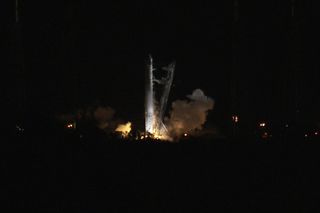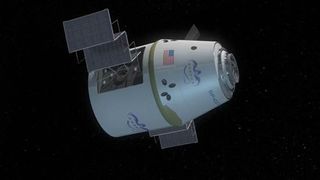SpaceX No Stranger to Launch Day Rocket Glitches

When a privately built rocket aborted its launch attempt at the very last second today (May 19), it was likely a familiar sight to the booster's builders: the California-based company SpaceX.
SpaceX's unmanned Falcon 9 rocket aborted its launchattempt this morning just as the countdown reached T minus 0.5 seconds and the rocket's nine main engines ignited, apparently due to an unexpectedly high engine pressure reading. The rocket will now have to wait until at least Tuesday (May 22) to attempt to launch SpaceX's first robotic Dragon space capsule flight to the International Space Station.
The launch abort, while a delay, isn't a surprising turn of events for SpaceX. The company repeatedly pushed back the launch in recent months to allow extra time to review the rocket and Dragon capsule's flight software. The goal, SpaceX and NASA officials said at the time, was to make sure the rocket was as ready to fly as possible.
As recently as April 30, SpaceX pushed the launch back when the Falcon 9 rocket experienced a hiccup during an engine test atop the launch pad. A second engine test later proved everything was ready for launch. [Photos: SpaceX Poised for Historic Launch]
No guarantees
SpaceX has a $1.6 billion contract to provide 12 Dragon capsule cargo flights to the space station for NASA, with this mission aimed at proving the space capsule's capabilities. With NASA's space shuttle fleet retired, the agency is depending on SpaceX and other commercial spaceship builders to provide much needed robotic cargo and manned vehicles to fill the void left by the shuttle program's end.
But SpaceX has repeatedly stated that the Falcon 9 and Dragon launch to the space station is an unprecedented test flight, one in which success is never guaranteed.
Get the Space.com Newsletter
Breaking space news, the latest updates on rocket launches, skywatching events and more!
"This mission is important, although I wouldn't want to place too much emphasis on the success of this mission, because it is a first time effort," SpaceX CEO and founder Elon Musk told SPACE.com in a recent interview. "If there's any danger or concern with respect to the space station, then we will have to abort and try again on a different flight."
Musk is a billionaire entrepreneur and co-founder of the Internet payment service Paypal. He founded the Hawthorne, Calif.-based SpaceX, formally known as Space Exploration Technologies Corp., in 2002 with the intention of developing a manned spacecraft capable of orbital and deep space flight.
The Falcon 9 rocket stands 157 feet tall (48 meters) and is a two-stage booster fueled by liquid oxygen and kerosene.
The challenge of private spaceflight
On Friday (May 18), SpaceX President Gwynne Shotwell acknowledged the company's challenges in hitting liftoff at launch time on the first try.
"We have not hit a T-Zero yet," Shotwell said, adding that she felt SpaceX had a better than 50-50 chance of launching today.
The current Falcon 9 mission is SpaceX's third mission for the rocket design, which made its debut in June 2010. A second flight successfully launched a Dragon capsule prototype into orbit in December 2010. The earlier Falcon 9 launches also saw delays or aborts, Shotwell said.
The Falcon 9 rocket's successful track record marked a major step forward for SpaceX, which launched three of its smaller Falcon 1 rockets before achieving a successful flight on the fourth try.

SpaceX's next chance to launch the Falcon 9 rocket and Dragon capsule toward the space station comes before dawn on Tuesday, with Wednesday (May 23) available as a backup day if it is needed, NASA officials said.
After standing down from today's launch attempt, Shotwell stressed that there's a big difference between a launch abort and an outright launch failure.
"This is not a failure," Shotwelll said. "We aborted with purpose. It would have been a failure if we had lifted off with an engine trending in this direction."
You can follow SPACE.com Managing Editor Tariq Malik on Twitter @tariqjmalik. Follow SPACE.com for the latest in space science and exploration news on Twitter @Spacedotcom and on Facebook.
Join our Space Forums to keep talking space on the latest missions, night sky and more! And if you have a news tip, correction or comment, let us know at: community@space.com.

Tariq is the Editor-in-Chief of Space.com and joined the team in 2001, first as an intern and staff writer, and later as an editor. He covers human spaceflight, exploration and space science, as well as skywatching and entertainment. He became Space.com's Managing Editor in 2009 and Editor-in-Chief in 2019. Before joining Space.com, Tariq was a staff reporter for The Los Angeles Times covering education and city beats in La Habra, Fullerton and Huntington Beach. In October 2022, Tariq received the Harry Kolcum Award for excellence in space reporting from the National Space Club Florida Committee. He is also an Eagle Scout (yes, he has the Space Exploration merit badge) and went to Space Camp four times as a kid and a fifth time as an adult. He has journalism degrees from the University of Southern California and New York University. You can find Tariq at Space.com and as the co-host to the This Week In Space podcast with space historian Rod Pyle on the TWiT network. To see his latest project, you can follow Tariq on Twitter @tariqjmalik.
